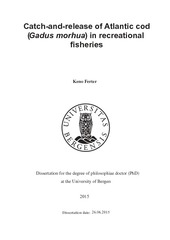| dc.contributor.author | Ferter, Keno | eng |
| dc.date.accessioned | 2015-08-27T09:31:37Z | |
| dc.date.available | 2015-08-27T09:31:37Z | |
| dc.date.issued | 2015-06-26 | |
| dc.identifier.uri | https://hdl.handle.net/1956/10363 | |
| dc.description.abstract | The role of recreational fisheries in the exploitation pressure on fish resources is increasingly recognized. This has led to the introduction of new harvest regulations for several European marine recreational fisheries. Such regulations have been shown to increase the practice of regulatory catch-and-release (C&R). Additionally, anglers have been shown to practice voluntary C&R due to various personal motivations. Access-point surveys in two study areas in Northern and Southern Norway found that marine angling tourists release more than 60% of their catch for several species due to regulatory and voluntary C&R. For Atlantic cod (Gadus morhua) alone, this corresponds to more than one million individuals released annually by angling tourists in Norway. A review of published, unpublished and grey literature on C&R for nine European marine recreational fisheries found that C&R is a common practice in many European countries. Among the studied European marine species caught by recreational anglers, the highest absolute release numbers were found for Atlantic cod. Impacts of C&R on Atlantic cod under best practice conditions, and the effects of different capture depths on barotrauma symptoms and post-release mortality of cod were investigated in a telemetry study and a containment study, respectively. The telemetry study showed that some cod show behavioral alterations after C&R, but can recover quickly if they are caught in shallow waters (<20 m) and properly handled before release. The containment study showed that even though cod develop several barotrauma symptoms depending on capture depth, short-term mortality due to barotrauma is negligible (assuming minimal predation) if cod submerge quickly and are otherwise not substantially injured. Based on these results and other studies, a framework for the development of best practice C&R guidelines for cod is presented. To ensure that the study findings are understood and adopted by fisheries managers and anglers, efficient communication is essential, which requires a combination of several communication channels, including scientific publications, the media and information flyers. Even though emergent animal welfare concerns could not be resolved, a better understanding of C&R impacts on cod through this thesis will hopefully contribute to improving recreational fishing practices, which subsequently may minimize sublethal C&R effects and lead to decreased post-release mortality of cod in the future. | en_US |
| dc.language.iso | eng | eng |
| dc.publisher | The University of Bergen | en_US |
| dc.relation.haspart | Paper I: Ferter, K., Borch, T., Kolding, J., and Vølstad, J.H. (2013). Angler behaviour and implications for management - catch-and-release among marine angling tourists in Norway. Fisheries Management and Ecology 20(2-3): 137-147. Full text not available in BORA due to publisher restrictions. The article is available at: <a href="http://dx.doi.org/10.1111/j.1365-2400.2012.00862.x" target="blank">http://dx.doi.org/10.1111/j.1365-2400.2012.00862.x</a>. | en_US |
| dc.relation.haspart | Paper II: Ferter, K., Weltersbach, M.S., Strehlow, H.V., Vølstad, J.H., Alós, J., Arlinghaus, R., Armstrong, M., Dorow, M., de Graaf, M., van der Hammen, T., Hyder, K., Levrel, H., Paulrud, A., Radtke, K., Rocklin, D., Sparrevohn, C.R., and Veiga, P. (2013). Unexpectedly high catch-and-release rates in European marine recreational fisheries: implications for science and management. ICES Journal of Marine Science 70(7): 1319-1329. Full text not available in BORA due to publisher restrictions. The article is available at: <a href="http://dx.doi.org/10.1093/icesjms/fst104" target="blank">http://dx.doi.org/10.1093/icesjms/fst104</a>. | en_US |
| dc.relation.haspart | Paper III: Ferter, K., Hartmann, K., Kleiven, A.R., Moland, E., and Olsen, E.M. (2015). Catch-and-release of Atlantic cod (Gadus morhua): post-release behaviour of acoustically pretagged fish in a natural marine environment. Canadian Journal of Fisheries and Aquatic Sciences 72(2): 252-261. The article is available at: <a href="http://hdl.handle.net/1956/8984" target="blank">http://hdl.handle.net/1956/8984</a>. | en_US |
| dc.relation.haspart | Paper IV: Ferter, K., Weltersbach, M.S., Humborstad, O.-B., Fjelldal, P.G., Sambraus, F., Strehlow, H.V., and Vølstad, J.H. (2015). Dive to survive: effects of capture depth on barotrauma and post-release survival of Atlantic cod (Gadus morhua) in recreational fisheries. ICES Journal of Marine Science.The article is available at: <a href="http://hdl.handle.net/1956/10091" target="blank">http://hdl.handle.net/1956/10091</a>. | en_US |
| dc.relation.haspart | Paper V: Dedual, M., Sague Pla, O., Arlinghaus, R., Clarke, A., Ferter, K., Geertz Hansen, P., Gerdeaux, D., Hames, F., Kennelly, S.J., Kleiven, A.R., Meraner, A., and Ueberschär, B. (2013). Communication between scientists, fishery managers and recreational fishers: lessons learned from a comparative analysis of international case studies. Fisheries Management and Ecology 20(2-3): 234-246. Full text not available in BORA due to publisher restrictions. The article is available at: <a href="http://dx.doi.org/10.1111/fme.12001" target="blank">http://dx.doi.org/10.1111/fme.12001</a>. | en_US |
| dc.subject | Dødelighet | NOB |
| dc.subject | Sportsfiske | NOB |
| dc.subject | Torsk | NOB |
| dc.subject | Trykk | NOB |
| dc.subject | barotrauma signs | |
| dc.subject | catch-and-release | |
| dc.subject | containment study | |
| dc.subject | gas embolism | |
| dc.subject | post-release mortality | |
| dc.subject | recreational fishing | |
| dc.subject | swimbladder rupture | |
| dc.subject | sublethal impacts | |
| dc.subject | acoustic telemetry | |
| dc.title | Catch-and-release of Atlantic cod (Gadus morhua) in recreational fisheries | en_US |
| dc.type | Doctoral thesis | |
| dc.rights.holder | Copyright the Author. All rights reserved | en_US |
| dc.identifier.cristin | 1251005 | |
